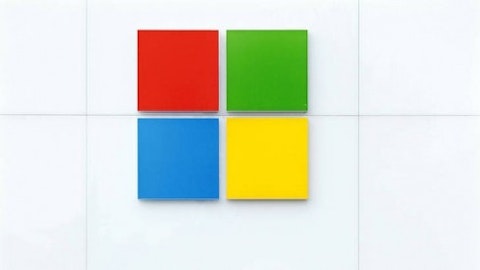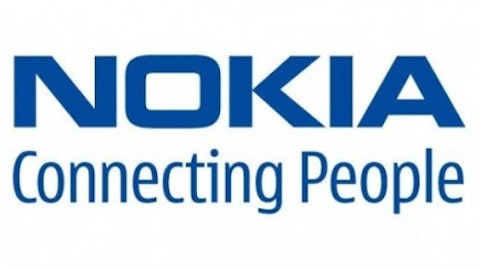In the fourth quarter of 2012, Nokia Corporation (ADR) (NYSE:NOK)’s earnings finally moved back into the black. In addition, its stock price continued to move higher on above-average volume. The problem with Nokia is that its fourth quarter earnings report left investors with more questions than answers. The biggest question is about how well Nokia’s smartphones will sell in China.

Nokia’s current position
Nokia Corporation (ADR) (NYSE:NOK) reported its fourth quarter earnings in January. The company had revenues of $8.04 billion versus revenues of $10.05 billion in the fourth quarter of 2011. The company’s earnings per share were $0.05, versus -$0.29 in the fourth quarter of 2011. On the surface, the news was good because the company reported profits for the first time since the second quarter of 2011. However, on a year over year basis, the company’s revenues were down by 25%.
Nokia Corporation (ADR) (NYSE:NOK)’s return to profitability was the result of its cost cutting efforts, which included selling assets, consolidating operations and laying off a third of its employees. The company is officially in survival mode, and it is trying to buy time in the hopes that the sales of its Lumia, its Microsoft Corporation (NASDAQ:MSFT) Windows 8-powered smartphones, will take off. In order to raise cash the company sold its headquarter building in Espoo outside of Helsinki, Finland, as well as its luxury handset maker unit Vertu. The company finished the quarter with $11.97 billion in cash, which was 22% lower than in the fourth quarter of 2011.
However, to Nokia Corporation (ADR) (NYSE:NOK)’s detriment, not is all has been going well for Microsoft’s Windows 8. Samsung has stopped selling its Windows RT tablets in Europe and blames Windows 8 for dampening PC market growth. According to a recent Forbes article that quoted Jun Dong-Soo, Samsung’s memory chip division president, “The global PC industry is steadily shrinking despite the launch of Windows 8. I think the Windows 8 system is no better than the previous Windows Vista platform.” He also said, “Microsoft’s rollout of its Windows Surface tablet is seeing lackluster demand. Meanwhile, previous vigorous pitches by Intel and MS for thinner ultra-books simply failed and I believe that’s mostly because of the less-competitive Windows platform.” This points to an even bigger problem for Microsoft – nearly all of the company’s long-time partners in the PC realm are angered by the release of Surface.
Microsoft reported quarterly revenue of $21.46 billion for the second quarter of fiscal 2013. The company reported net income of $6.38 billion for the quarter, up from $5.87 billion in the same quarter of 2012. Earnings per share (EPS) of $0.76 were lower than in the same quarter in 2012. To my surprise, Microsoft’s Windows division, home to Windows 8, saw revenues jump 24% since the same quarter last year, generating nearly $5.9 billion in revenue. Despite these numbers, the core issue for Nokia is how Windows 8 is viewed. Is it an asset or a burden? Nokia Lumia users may have a better perception of Windows 8, but I believe it is more of a threat to Nokia than a tailwind.
Since its fourth quarter earnings announcement, Nokia Corporation (ADR) (NYSE:NOK)’s stock price has retreated sharply on extremely heavy volume. One of the primary reasons for the retreat is because investors are worried about the company’s drop in revenue from its smartphone sales. In the quarter the company sold 6.6 million smartphones; 2.2 million of those sales were of its old Symbian powered smartphones and 4.4 million were of its flagship Lumia model smartphones. These sales numbers were worrisome because Nokia’s future depends upon the success of its Lumia smartphones, and fourth quarter sales did not meet expectations. Nokia’s smartphone revenues were also disappointing, as they were down by 55% from the fourth quarter of 2011. Also, its 18% gross margin was deemed unsustainable, and was less than half of Apple’s iPhone’s gross margin of 38.6%. Despite the fact that Nokia has reduced its smartphone operating expenses by 34%, its margins were low because it was forced to reduce the price of its phones in order to maintain market share.
Nokia’s partnership with China Mobile Ltd. (ADR) (NYSE:CHL)
Nokia Corporation (ADR) (NYSE:NOK)’s stock price has improved by 120% since its July low of $1.63. Two of the primary reasons for the run-up in the stock price were reports that its new Lumia smartphones were selling out in phone stores around the world, as well as the announcement that it had inked an exclusive deal to sell its phones to China Mobile Ltd. (ADR) (NYSE:CHL), the world’s biggest mobile operator. We now know that the fourth quarter sales numbers for Lumia smartphones were not as high as Nokia investors had hoped for. However, when it comes to China Mobile Ltd. (ADR) (NYSE:CHL), it is still too early to accurately predict the number of Lumia smartphones that Nokia will sell as a result of its Dec. 5, 2012 partnership deal. Analysts have said that Nokia needs to sell 10 million Lumia’s per quarter in order to stay in business. That is why it is so important for its partnership with China Mobile to work.
Fourth quarter results showed that sales of Nokia Corporation (ADR) (NYSE:NOK) smartphones in China Mobile Ltd. (ADR) (NYSE:CHL) were down by 79%. However, the Nokia/China Mobile partnership did not go into effect until the first quarter of 2013, and as a result of the partnership, sales of its Lumia smartphones are sure to increase. What is in question is whether the partnership arrangement will push the sales of Lumia’s near to the 10 million quarterly sales point that may be required to keep Nokia afloat. While on paper the Nokia/China Mobile deal looks great, it is hard to predict how it will affect Nokia’s smartphone sales because it will still have to fend off Apple and its iPhones, as well as Google Inc. (NASDAQ:GOOG) and the phones that use its Android operating system.
Company analysis
After six straight quarters of losses, Nokia Corporation (ADR) (NYSE:NOK) finally turned a profit in the fourth quarter. However, the way that Nokia made its profit brought up more questions than answers. The company made a profit by cost cutting and through its partnership with Siemens. Unfortunately, its revenues were down by 25% on a year-over-year basis. It is nice that the company was able to turn a profit, but sooner rather than later it will need to increase revenues, and it will need to do that through the sales of it smartphones. The company’s smartphone sales are falling in Latin America and Asia, and are losing ground to Apple and Samsung in North America. This means that the company’s best chance of remaining profitable is through its partnership with China Mobile Ltd. (ADR) (NYSE:CHL) in China. The problem for investors is that there are big uncertainties that come with the China Mobile partnership. For instance:
How many Lumia smartphones can China Mobile sell?
Will China Mobile have to sell Lumia smartphones at a discount in order to compete?
Will the sellers of Apple iPhones and Google’s Android based smartphones reduce their prices in order to maintain market share?
Nokia Corporation (ADR) (NYSE:NOK) CEO Stephen Elop has bet the company’s future on the success or failure of its Lumia smartphones. If its Lumia smartphones sales are successful in China Mr. Elop will be a winner and Nokia will survive–if sales slump Mr. Elop will be a loser and Nokia’s future will be uncertain.
Stock analysis
Nokia Corporation (ADR) (NYSE:NOK)’s future is still very uncertain, and after a better than 120% run-up in its stock price over the last six months, its stock, which has recently been falling, could be in danger of taking an even greater hit. I will not recommend this stock to investors until I see evidence that Nokia’s China strategy will prove successful.
The article Nokia’s Fate Is Tied To China originally appeared on Fool.com and is written by Max Fisher.
Copyright © 1995 – 2013 The Motley Fool, LLC. All rights reserved. The Motley Fool has a disclosure policy.


